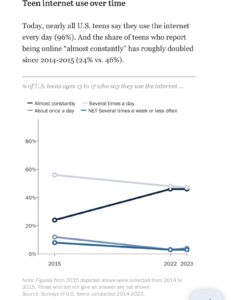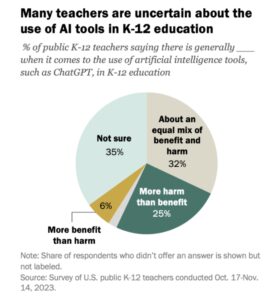The Traveling Teacher Blog! My EdTech Vision
My vision for education is to build skills for lifelong learning, and to develop positive growth and confidence amongst each student in an ever-changing global environment. Without a doubt, technology plays a key role in school vision statements in 2024. Internet usage takes center stage in modern life, particularly amongst teens as highlighted by figures gathered in a survey of U.S. teens which reveals that nearly 90% of teenagers use the internet ‘almost constantly’ or ‘several times a day:’
 (Faverio et al., 2024, p.4). Survey findings demonstrate the increase of internet usage over time, reflecting the way in which our world now operates.
(Faverio et al., 2024, p.4). Survey findings demonstrate the increase of internet usage over time, reflecting the way in which our world now operates.
Instilling confidence in students looks like preparing them for the wider world of work. This is something that school technology researchers such as Seymour Papert have explored as early as the 1970s. In ‘Twenty Things to do with a Computer’ (1971), Papert and Soloman call for schools to use computers to ‘produce some action.’ (Papert and Soloman, 1971, p.2). My school vision therefore involves being creative with curriculum design to help make connections between school subjects and life beyond the walls of school. For example, the integration of new technologies such as AI in curricular areas like Art and Design may help students explore subject areas in a different way. In her article ‘AI vs Artist: The Future of Creativity’ (2023), Jessica Campitiello interviews Adobe’s Chief Product Officer who states that the integration of AI in Art means that ‘creative confidence is only going to grow.’ (Campitiello, 2023, p.1) This implies that AI technologies could allow students to access subject areas that may once have only been reserved for those with natural talent.
However, as alluded to by Papert and Soloman (1971), there continues to be a disconnect between school use of technology and ‘real world’ application. Schools are, in many ways, afraid of technology. In a recent survey, a quarter of U.S. Teachers say AI tools do more harm than good in K-12 education (Lin, 2024, p.1) indicating that an overwhelming majority of teachers are either unsure or feel that AI hinders more than helps K-12 students.
Reasons behind such results may be due to a variety of factors including lack of knowledge on AI platforms and access to professional learning opportunities which, in turn, can generate a fear of the unknown.
Whilst many may view technology, in particular AI, in schools, to use Plato’s wording, a ‘cave,’ I deem AI to be the inevitable and therefore an important part of an EdTech vision in 2024. AI appears as a threat in school communities as concerns over issues such as safeguarding, child protection and job security cast doubt over the use of such technologies in a school. While these concerns are valid, arguably AI presents teachers with more opportunities than threats as these technologies can be used to help prepare students for an unknown future.
Flexibility in a school vision statement is therefore important as our world continues to change rapidly and with this, technological advancements will not only shape the way our world operates but will impact what our young people access outside of school. It’s time for schools to invest in AI professional learning to help teachers make a difference in children’s learning. In doing so, teachers will be able to develop skills for life amongst students.
Bibliography
Campitiello, Jessica. (2023, February 20). AI vs. Artist: The Future of Creativity. Retrieved from https://tech.cornell.edu/news/ai-vs-artist-the-future-of-creativity/
Faverio, Michelle, Sidoti, Olivia, Atske, Sara and Park, Eugenie. (2024) Teens and Internet, Device Access Fast Sheet. Retrieved from https://www.pewresearch.org/internet/fact-sheet/teens-and-internet-device-access-fact-sheet/
Lin, Luona. (2024, May 15). A quarter of U.S. teachers say AI tools do more harm than good in K-12 education. Retrieved from https://www.pewresearch.org/short-reads/2024/05/15/a-quarter-of-u-s-teachers-say-ai-tools-do-more-harm-than-good-in-k-12-education/
Papert, Seymour and Soloman, Cynthia. (1971) Twenty Things To Do With A Computer. Retrieved from https://dspace.mit.edu/handle/1721.1/5836
Plato. (360 B.C.E.). The Allegory of the Cave. Retrieved from https://auca.kg/uploads/The_Allegory_of_the_Cave%5B1%5D.pdf


